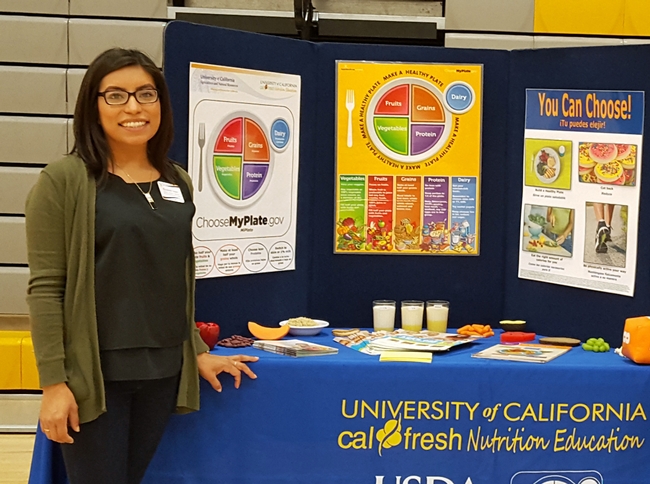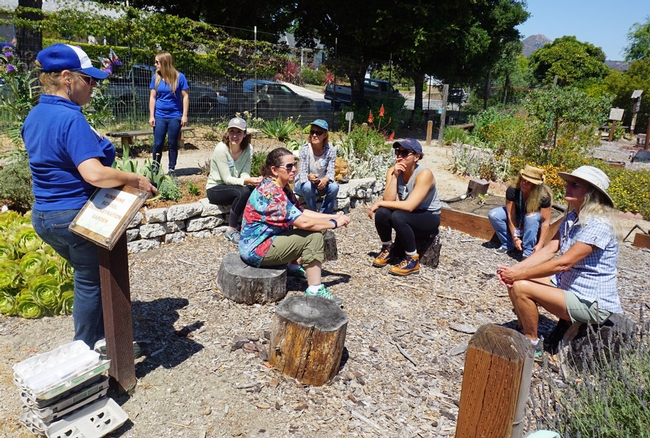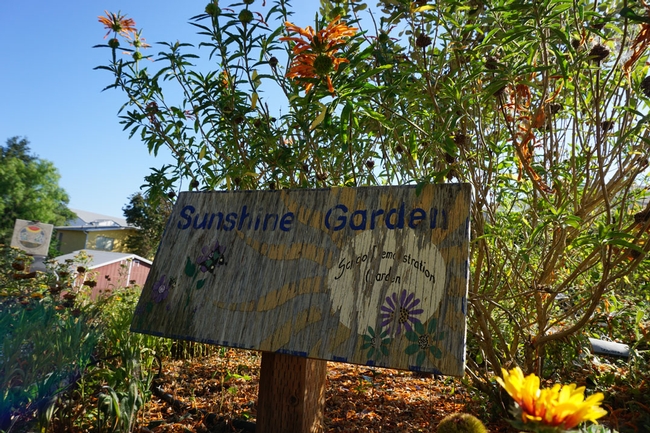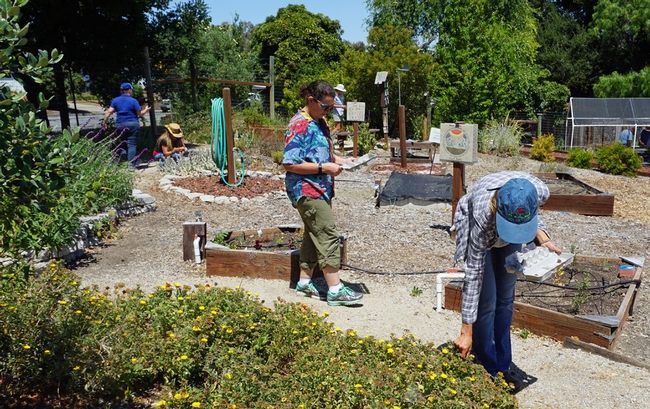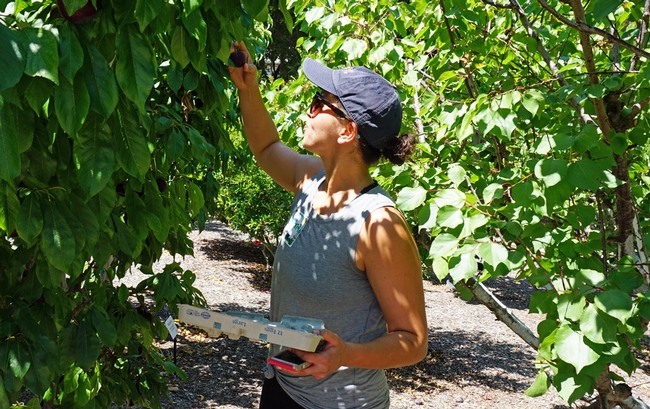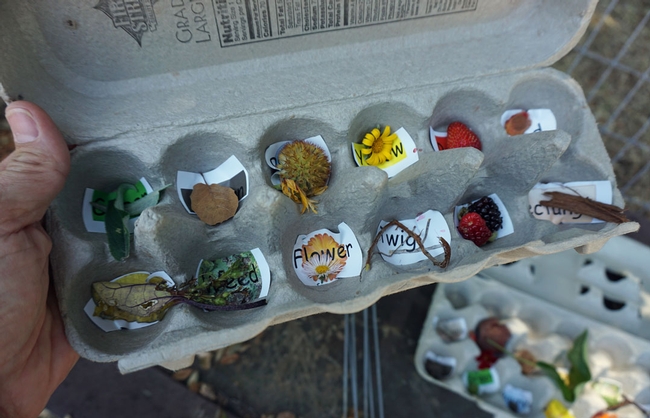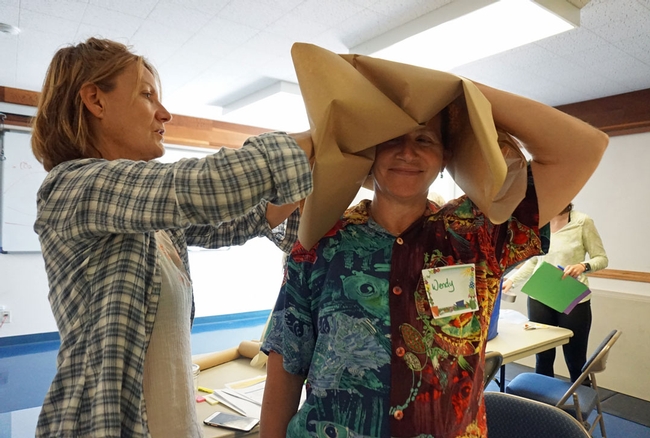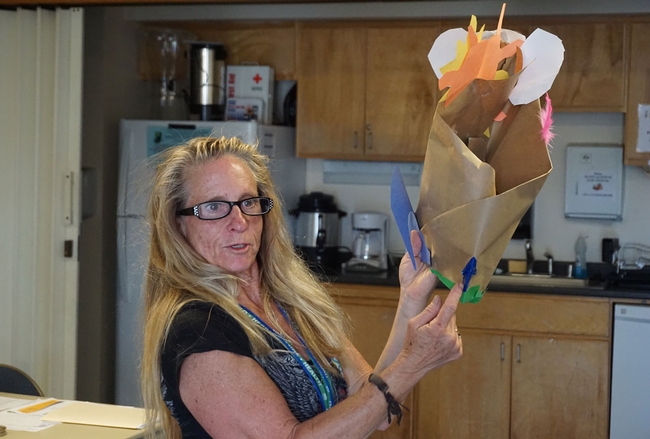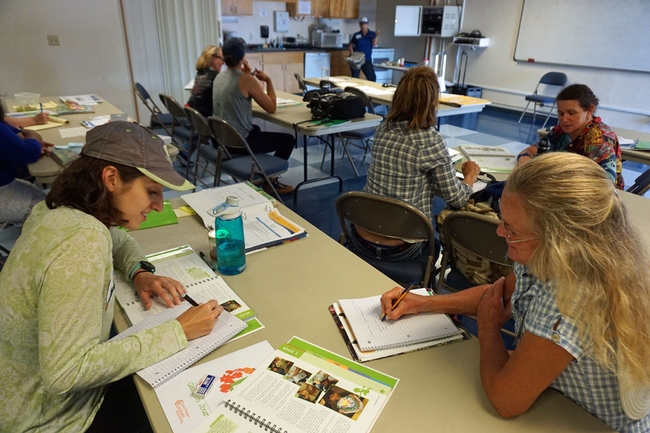
Posts Tagged: UC CalFresh
Youngsters learn cooking from 4-H teens in Imperial County
Two UC Cooperative Extension programs - 4-H Youth Development and UC CalFresh nutrition education - collaborate to give Imperial County elementary school students an introduction to the culinary arts, reported Vincent Osuna in the Imperial Valley Press.
The 4-H Teens-As-Teachers Cooking Academy runs seven sessions in which the high school students use evidence-based curriculum from 4-H to teach the elementary school students how to cook.
"I think this is a really good experience for the kids because it shows them the pathways that are here at the high school that could lead them into their future," said a Calexico High School senior Nelly Rodriguez, who serves as an academy teacher. "It gets them a start way ahead of what we got, because we started in ninth grade, and they get to start young in elementary."
A 4-H mini-grant funded equipment, aprons, skillets and other materials; UC CalFresh provides the food ingredients.
"It's to basically teach kids how to cook, but also just to empower them to help them feel like they have a little more control over their food," said Chris Wong, UCCE Imperal County community education specialist. "At the same time, it serves purpose to the high school culinary class because it professionally develops them for their food demos and their competitions at the end of the year."
4-H teen teacher Julio Ramirez said the young students were nervous at first, but by the fourth session, "They're anxious to do it. It's just a good thing to see."
Keep food safe with advice from UC CalFresh
Always be mindful of the time when food is outside a refrigerator or freezer. Typically, it should be no longer than two hours, and just one hour in the summertime, according to UC Cooperative Extension UC CalFresh nutrition program coordinator Elizabeth Lopez in an appearance on the Valley Pubic Television program Valley's Gold. (The food safety segment begins at the 18:30 mark.)
Lopez recommends using an insulated grocery bag with a frozen ice pack for the trip home from the store, and refrigerating leftovers in sealed containers soon after finishing a meal to maintain food safety.
The UC Cooperative Extension nutrition educator also provided cooking tips with program host Ryan Jacobson, the director of the Fresno County Farm Bureau. Lopez noted:
- Before beginning, wash hands with warm water and soap for 20 seconds.
- Make sure the food preparation area is clean.
- Designate certain cutting boards for fruit and vegetables, and others for meat and poultry.
- Wash fruit and vegetables under cool running water. No detergent is needed. Read the labels on pre-bagged produce. Some are ready to use, some need to be washed.
- Use a meat thermometer. Cook beef, pork and lamb to an internal temperature of 145 degrees F. Ground meats should be cooked to 160 degrees F. Poultry, whole or ground, should be cooked to 165 degrees F.
For more information, Lopez suggested consumers consult the USDA's Food Safety.gov website or Food Keeper app, available free in the app store.
November News Clips (11/1-11/14)
As wildfires grow deadlier, officials search for solutions
(Associated Press) Matthew Brown and Ellen Knickmeyer, Nov. 14
…"There are ... so many ways that can go wrong, in the warning, the modes of getting the message out, the confusion ... the traffic jams," said Max Moritz, a wildfire specialist with the University of California Cooperative Extension program.
As deadly urban wildfires become more common, officials should also consider establishing "local retreat zones, local safety zones" in communities where residents can ride out the deadly firestorms if escape seems impossible, Moritz said.
… In the mid-20th century, California ranchers burned hundreds of thousands of acres annually to manage their lands, said Lenya Quinn-Davidson, director of the Northern California Prescribed Fire Council.
That was phased out in the 1980s after California's fire management agency stepped in to take over the burns, and by the last decade, the amount of acreage being treated had dropped to less than 10,000 acres annually, Quinn-Davidson said.
Former agricultural land that rings many towns in the state became overgrown, even as housing developments pushed deeper into those rural areas. That was the situation in the Northern California town of Redding leading up to a fire that began in July and destroyed more than 1,000 homes. It was blamed for eight deaths.
"You get these growing cities pushing out - housing developments going right up into brush and wooded areas. One ignition on a bad day, and all that is threatened," Quinn-Davidson said. "These fires are tragic, and they're telling us this is urgent. We can't sit on our hands."
http://www.kulr8.com/story/39483128/fatal-california-fires-spur-search-for-solutions
Camp Fire vs. Tubbs Fire: The two most destructive fires in California history
(San Francisco Chronicle) Amy Graff, Nov. 14
Comparing California's most destructive wildfires -- the current Camp Fire and last year's Tubb's Fire -- College of Natural Resources Dean Emeritus Keith Gilless, also a forest economics professor, says: "One fundamental difference that occurs to me is that the Tubbs fire broke out late at night, which made notification and evacuation particularly difficult." Professor Gilless also discussed California's wildfires on WBUR's On Point program.
Trump and Brown stir up rhetoric on wildfires but overlook pressing problems
(LA Times) Bettina Boxall, Nov. 14
… “I've been following these issues for 40 years, and I don't remember a time when the issue of wildfire has ever been politicized anywhere close to the extent it is now,” said Richard Frank, director of the California Environmental Law and Policy Center at UC Davis.
… Similarly, UC Berkeley fire scientist Scott Stephens said that although climate change is playing a role in wildfire growth, he worries that a focus on global warming can leave the public thinking that “there's really nothing to be done.”
In fact, he said, “Communities could still be better prepared.”
http://www.latimes.com/local/lanow/la-me-fire-policy-trump-brown-20181114-story.html
Staggered evacuation plan questioned in fire's aftermath
(Associated Press) Paul Elias, Kathleen Ronayne, Nov. 14
…Paradise sits on a ridge between two higher hills, with only one main exit out of town. The best solution seemed to be to order evacuations in phases, so people didn't get trapped.
“Gridlock is always the biggest concern,” said William Stewart, a forestry professor at the University of California, Berkeley.
…Likewise, Stewart, the forestry professor, said the wildfire that hit Paradise disrupted the orderly evacuation plan because it “was moving too fast. All hell broke loose.”
He said experts continue to debate how best to issue evacuation orders and no ideal solution has been found.
Blueberry growers focus on open market window
(Ag Alert) Padma Nagappan, Nov. 14
…It makes sense to tap the market earlier in the year, when California growers are not competing with others entering the market and there are better margins to be had. That's why Ramiro Lobo and others from the University of California have been working on a long-term berry trial in Southern California, to look for the best varieties that can be produced early in the year.
"You have to be in the market as early as you can, because by April and beginning of May, the prices are so low, it doesn't even pay for the harvest," Lobo said. He is a small farms and agricultural economics advisor with UC Cooperative Extension.
http://www.agalert.com/story/Default.aspx?id=12300
Sanitation is foundation of Navel orangeworm control
(Farm Press) Logan Hawkes, Nov 14
So far this year, early estimates reveal that nut damage and subsequent losses from NOW larvae, will be less than in 2017, though the pest remains a major concern in almond, pistachio, and even walnut orchards. University of California Agriculture and Natural Resource (UC-ANR) advisors note that a successful management plan for controlling Navel orangeworm starts in the fall following harvest and continues through the winter months.
"Sanitation is the foundation of Navel orangeworm control," says Pheobe Gordon of UC Cooperative Extension. "Post-harvest sanitation is the first step in slowing the emergence of the pest when the new season begins."
… UC-ANR Extension IPM Specialist Dr. Jhalendra Rijal is one of the leading researchers on Navel orangeworm control in almonds and walnuts. "We have been working vigorously to better understand Navel orangeworms, how they reproduce, migrate, and survive,” he says.
https://www.westernfarmpress.com/tree-nuts/sanitation-foundation-navel-orangeworm-control
How Does California's Wildlife Cope With Massive Wildfires?
(Atlas Obscura) Anna Kusmer, Nov. 13
While many animals are indeed displaced by wildfires, it's important to note that fire is not wholly bad for landscapes in an ecological sense. In fact, many California ecosystems rely on fire to thrive. “Fire in the human sense can often be catastrophic, but it's not necessarily the same for animals,” says Greg Giusti, a retired University of California researcher and an expert on the relationship between wildfires and wildlife. He says California wildlife have evolved to respond to fires, and can even sometimes benefit from the disruption. “It's harsh out there, but you know these animals have evolved to survive in that hostile environment.”
There are a variety to survival tactics that California wildlife will use, says Giusti. For example, birds are easily able to fly away and are usually not impacted as long as fires don't occur during the spring when they are nesting and raising their offspring.
https://www.atlasobscura.com/articles/how-does-californias-wildlife-cope-with-massive-wildfires
The Manmade Causes Of California's Endless Fire Season
(OnPoint) Meghna Chakrabarti, Nov 13
California's endless fire season. Whether it's climate change, development or forest management, we'll look at the causes — all manmade.
Guests:
Scott McLean, deputy chief, chief of information for the California Department of Forestry and Fire Protection.
Ryan Lillis, reporter for the Sacramento Bee who has covered most of Northern California's fires for last 12 years. (@Ryan_Lillis)
J. Keith Gilless, professor of forest economics at University of California, Berkeley and chair of the California Board of Forestry and Fire Protection on Cal Fire's policy board.
Glen MacDonald, professor of geography at University of California, Los Angeles who has spent decades studying climate and the effects of wildfires. He and his family were among the hundreds of thousands of people who evacuated their homes because of the Woolsey Fire. (@GlenMMacDonald1)
http://www.wbur.org/onpoint/2018/11/13/californias-endless-fire-season-climate-change
California Must Better Prepare For The Inevitability Of Future Fires
(Pacific Standard) Max Moritz, Naomi Tague & Sarah Anderson, Nov 13
Wildfire has been an integral part of California ecosystems for centuries. Now, however, nearly a third of homes in California are in wildland urban interface areas where houses intermingling with wildlands and fire is a natural phenomenon. Just as Californians must live with earthquake risk, they must live with wildfires.
https://psmag.com/environment/california-must-better-prepare-for-future-fires
Forest management debate
(KTVU) Heather Holmes, Nov. 12
In a live interview, Bill Stewart, UC Cooperative Extension specialist at UC Berkeley, said,
“It was actually on the private land that we saw better performance in terms of being able to put out the fire quicker and a lot less smoke being produced. There is a package of vegetation management and fire suppression on private lands that have proved to be more effective than what's being used on federal land.
“What we found is about half the difference comes from the private land managers do more aggressive timber harvesting and some of that profit they spend to reduce the shrubs and fuels that are on the ground because they have that cashflow. They're protecting their long-term assets. The other half is CALFIRE is much more aggressive when it comes to fire suppression in forests or shrublands.
http://www.ktvu.com/news/372545595-video
Trump Right? Hack-and-Squirt the Forest. Created the Huge California Fire Hazard
(Mary Greeley News) Mary Greeley, Nov. 12
On average, the cost of thinning forests through hack-and-squirt while leaving the dead trees standing is about $250 per acre, said Greg Giusti, a forest advisor with the University of California Cooperative Extension. The cost of cutting and leaving them on the ground is about $750 an acre, while cutting and hauling them away is about $1,000 an acre.
https://www.youtube.com/watch?v=tEOETb7ttaY
Trump's Misleading Claims About California's Fire ‘Mismanagement'
(New York Times) Kendra Pierre-Louis, Nov. 12
…Mr. Trump is suggesting that forest management played a role, but California's current wildfires aren't forest fires.
“These fires aren't even in forests,” said Max Moritz, a wildfire specialist at the University of California, Santa Barbara.
…“We have vulnerable housing stock already out there on the landscape. These are structures that were often built to building codes from earlier decades and they're not as fire resistant as they could be,” Dr. Moritz said. “This issue of where and how we built our homes has left us very exposed to home losses and fatalities like these.”
https://www.nytimes.com/2018/11/12/us/politics/fact-check-trump-california-fire-tweet.html
Carbon Farming Initiative Takes Tentative First Steps in Santa Ynez Valley
(Noozhaw) Garrett Hazelwood, Nov. 12
On a recent morning in the Santa Ynez Valley, a crowd of people gathered at the Ted Chamberlin Ranch to discuss soil health and so-called carbon farming.
The event –– hosted by the Community Environmental Council, the Cachuma Resource Conservation District, and the Santa Barbara Agricultural Commissioner's Office –– showcased successful carbon farming trials recently conducted on the ranch, and was attended by local landowners, environmental activists, scientists and county officials.
Matthew Shapero, Livestock and Range Advisor for the UC Cooperative Extension, explained that the grasses surrounding the site had sprouted green last spring and have since died in the heat of summer, becoming what he calls “residual dry matter.” Now the brittle, golden shoots have become a sparse cover for hard-packed soil that's cracked and dry.
California's year-round wildfire threat: Why aren't communities doing more?
(SF Chronicle) Peter Fimrite and Kurtis Alexander Nov. 10,
…“To have a president come out and say it's all because of forest management is ridiculous. It completely ignores the dynamic of what's going on around us.” said LeRoy Westerling, a climate and fire scientist at UC Merced, who blamed the increasing number of fires on rising temperatures and more variable precipitation, leading to longer spells of dry weather.
…“It's like a tragic replay of last year, with strong winds in both Northern California and Southern California blowing fire,” said Max Moritz, a wildfire specialist at the Bren School at UC Santa Barbara, recalling the 2017 Wine Country fires and the Thomas Fire, which burned through Ventura and Santa Barbara counties in December.
…“We had a lot of discussion after the fires last year about the liability issue with utilities, but it's interesting to see what didn't happen,” Moritz said. “Nobody has talked about mapping neighborhoods and homes in fire-prone areas like they do in flood plain hazard zones, engineering resilience into communities, or building a little smarter.”
…Everybody agrees the situation is dire. Fire officials blame shorter winters, hotter temperatures and drier vegetation, but very little is being done to improve the situation, said Scott Stevens, a professor of fire science at UC Berkeley.
“There is an under-appreciation of fire risk in a lot of communities,” Stevens said. “It feels like we can do better at allowing local communities to access information, reduce their vulnerability and understand their vulnerability a little bit more.”
Stevens urged the creation of cooperative programs at his and other universities that would allow local government officials to collaborate with fire experts on safety planning.
California's most destructive wildfire should not have come as a surprise
(LA Times) Bettina Boxall and Paige St. John, Nov. 10
…“We have these Santa Ana-like events happening in places that are appearing to catch people by surprise,” said Max Moritz, a cooperative extension wildfire specialist at UC Santa Barbara's Bren School. “But they shouldn't be catching people by surprise.”
“These are areas that have burned before,” he said. “And if we were to go back and do the wind mapping, we would find that at some intervals, these areas are prone to these north and northeasterly Santa Ana-like events.”
… “We have all kinds of tools to help us do this smarter, to build in a more sustainable way and to co-exist with fire,” he said. “But everybody throws up their hands and says, ‘Oh, all land-use planning is local. You can't tell people that they can't build there.' And the conversation stops right there.”
http://www.latimes.com/local/lanow/la-me-camp-fire-science-20181110-story.html
Are Organic Farms Ruining California's Rural Coast?
(Pacific Standard) Laura Fraser, Nov. 9
David Lewis, county director of the UC Cooperative Extension in Marin County, estimates that the Point Reyes ranches contribute as much as 20 percent of the county's $110 million in annual agricultural production. Given the industries that support agriculture—feed companies, veterinary services, a grass-fed beef butchery—the overall economic output of the ranches may be three times that amount. If the ranches closed, Lewis says, "You'd be losing about $60 million a year in production." The ranchers also contribute more than 5,000 jobs in the region, on and off the farms.
https://psmag.com/.amp/environment/are-organic-farms-ruining-california-rural-coast
Countries Embrace Genome Editing in Contrast of EU's Opinion
(AgNet West) Brian German, Nov. 8
The United States joined 12 other nations to encourage policies to enable continued agricultural innovation, including genome editing. Australia, Canada, Brazil, and Vietnam were among the countries issuing support of the International Statement on Agricultural Applications of Precision Biotechnology. Noticeably absent from the joint statement of support was the European Union (EU).
…“Ideally, or in theory, regulations are meant to be in place to address risk. And so the more risk, the more regulation and the less risk the less regulation,” said Alison Van Eenennaam, Animal Genomics and Biotechnology Specialist at UC Davis. “But in this case, it's just regulation triggered by a particular process irrespective of the risk of the product.”
http://agnetwest.com/countries-genome-editing-contrast-eu/
University of California's Glenda Humiston wins 2018 California Steward Leader Award
(CA Economy) Nadine Ono, Nov. 8
Glenda Humiston has always been involved in rural issues from her days growing up on a farm to her current position as vice president of University of California Division of Agriculture and Natural Resources.
“I was really involved in the 1990s in trying to figure out how agriculture and environmental interests find common ground, as well as building bridges between rural and urban sectors," said Humiston. "In the 2000s, I started focusing on economic development and sustainability. In my current job, I'm bringing all of those together around the reality that sustainability truly has to be a triple bottom line. We've got to develop ways for people, the planet and prosperity to all thrive and enhance the synergies between them."
Humiston will be awarded the 2018 California Steward Leader Award at the California Economic Summit. She currently serves on the 2018 Economic Summit Steering Committee, as well the Action Team co-lead for Working Landscapes and co-chair of the Elevate Rural California initiative.
Instances of Bindweed Popping Up in Central Valley Farms
(AgNet West) Brian German, Nov. 7
Waterhemp is continuing to cause some concern in and around Merced County, but there is another problematic weed species that growers should be aware of and remain on the lookout for. “Bindweed is actually a big problem throughout the central valley of California,” said Agronomy and Weed Science Advisor for Merced and Madera Counties, Lynn Sosnoskie. “It's really a concern particularly where we have crops that are grown on drip irrigation and reduced tillage systems.”
http://agnetwest.com/bindweed-popping-central-valley-farms/
Agriculture group to hear from extension speaker
(Ventura County Star) Nov. 7
The Ventura County chapter of California Women for Agriculture will host a presentation by Annemiek Schilder of the University of California Cooperative Extension and Hansen Agricultural Research and Extension Center.
Minorities Are Most Vulnerable When Wildfires Strike in U.S., Study Finds
(New York Times) Kendra Pierre-Louis, Nov. 3
…The study, which appears in the journal PLoS One this month, suggests that people of color, especially Native Americans, face more risk from wildfires than whites. It is another example of how the kinds of disasters exacerbated by climate change often hit minorities and the poor the hardest.
…Rachel Morello-Frosch, a professor of environmental health at the University of California, Berkeley, said the research could be useful in preparing for future disasters. “Results of this study can help inform planning and outreach efforts to enhance the resilience of fire-prone communities, particularly for communities of color that are often overlooked when these disasters happen,” she said in an email.
https://www.nytimes.com/2018/11/03/climate/wildfires-minorities-risk.html
Wildfire Risk A Key Issue In California Insurance Commissioner Race
(Capital Radio) Ezra David Romero, Nov. 2
…"I recently talked to a homeowner who had his insurance canceled about three months before his house was destroyed by a wildfire,” said UC Cooperative Extension forestry and natural resources advisor Susan Kocher.
Kocher says calls from homeowners come often, and that people's reality is something the new commissioner will have to deal with: a complicated insurance system and a warming climate that's increasing the number, size and impact of fires in California.
A New Hue
(California Bountiful) Kevin Hecteman, Nov. 1
… C. Scott Stoddard, a University of California Cooperative Extension farm advisor in Merced County, is running trials with different purple varieties, working in concert with a sweet potato breeder at Louisiana State University.
One recent test variety, he noted, started off well from a color and yield standpoint a couple of years ago, but the interior color wasn't quite purple enough—he was getting more of a lavender potato.
"We are still very experimental," Stoddard said. "There's nothing that looks like it's going to have something there any time soon."
http://www.californiabountiful.com/features/article.aspx?arID=2204
Eating right learned at school
(Roseville Press Tribune) Carol Feineman, Nov. 1
More than 25 percent of youth ages 5 to 19 are overweight in Placer and Nevada counties, according to University of California CalFresh Nutrition Education Program, Placer/Nevada counties. The program is part of the University of California Cooperative Extension.
UC CalFresh is trying to lower that percentage by offering nutrition classes for adults and also teaching some Roseville, Lincoln and Sheridan public school students how to eat healthier. The organization also works with area school gardens.
…“As students get older, they're making more of the choices themselves. So many kids end up being home by themselves or packing their lunch,” said Rosemary Carter, UC CalFresh program manager for Placer-Nevada Counties. “I want them to understand what the healthy foods will do for their bodies. I want them to make the healthy choices, to make an educated choice.”
http://www.thepresstribune.com/article/11/01/18/eating-right-learned-school
Why the FDA's plan to regulate gene editing in animals has some scientists worried
(Pacific Standard) Emily Moon, Nov 1
…While genetically engineered animals have been met with controversy, animal geneticist Alison Van Eenennaam believed her own work would be immune. In her lab at the University of California–Davis, Van Eenennaam uses genetic editing technology to develop cows without horns. The process, she says, is no different than traditional breeding, in which breeders select for naturally occurring mutations. "Nature does this routinely, because there are always breaks getting introduced into double-stranded DNA by radiation and sunlight and alcohol, you name it," she says. "That's how evolution happens."
New preschool food mural to encourage healthful eating to be unveiled Feb. 23
Students' surroundings can greatly impact their learning and health, research has shown.
In an effort to enhance nutrition, learning and health for these students in Oakland, the University of California Cooperative Extension, UC CalFresh Nutrition Education Program, Luther Burbank Preschool and Oakland Unified School District Early Childhood Education supported the installation of a mural that features silhouettes of children of different abilities among flowers, fruit and other foods cast in bold colors at Burbank Preschool.

Luther Burbank Preschool Center is an inclusive school serving the needs of over 200 students, ages 3 to 5, of varying abilities and needs. The Burbank preschool students and teachers helped paint the mural.
“Our students worked on the mural first, then David [Burke] completed it,” said Principal Tom Guajardo. “This project has been absolutely uplifting for our students, staff and parents. I say ‘uplifting' because I have heard comments like, “‘When I am feeling a little down or tired, I come and see the mural and I am immediately rejuvenated.' It has been a showcase when parents and visitors come to our school.”
On Friday, Feb. 23, at 2 p.m. - 3:30 p.m. the mural will be unveiled in the cafeteria of Luther Burbank Preschool at 3550 64th Avenue in Oakland. Parents, teachers and students are invited to a celebration to meet David Burke, the mural designer and well-known Bay Area artist. The UC CalFresh staff is planning some activity stations including a healthy cooking demonstration with free recipe books and a table where children can make “veggie faces” using fresh produce and hummus for dipping.
School gardens get new life from UC Cooperative Extension volunteers
When children grow their own fresh fruits and vegetables, they are much more likely to eat healthy food, so for decades California politicians, teachers and nutrition educators have advocated for a garden in every school. However, UC Cooperative Extension experts in Santa Barbara and San Luis Obispo counties found that garden care can dwindle over time.
“Students and their parents ‘age out' of their elementary schools,” said Shannon Klisch, UC CalFresh community education supervisor in San Luis Obispo and Santa Barbara counties. “The turnover in expertise and level of commitment can vary widely, leaving some schools with either weedy, abandoned vegetable patches, or no garden support at all.”
UCCE offers UC CalFresh, federally funded nutrition education for CalFresh recipients (formerly called Food Stamps). UC CalFresh nutrition educators in Santa Barbara and San Luis Obispo counties saw a need to mobilize highly trained community members who could develop, support, sustain and teach from school gardens. UC CalFresh joined with UC's 4-H Youth Development, Master Food Preserver, and Master Gardener programs to launch a pilot project called “UC Garden Nutrition Extenders.”
“We don't have enough staff to work the gardens in every school, so we've started recruiting and training volunteers,” said Lisa Paniagua, school garden sustainability coordinator for the UC Garden Nutrition Extender program in San Luis Obispo and Santa Barbara counties.
“By enlisting passionate volunteers, nutrition educators could significantly multiply the number of students who had access to school gardens, nutrition education, and training in science, technology, engineering, and math (STEM) in the garden,” said Katherine Soule, Ph.D., youth, families, and communities advisor in San Luis Obispo and Santa Barbara counties.
Klisch said UC Garden Nutrition Extenders are local members of their school communities.
“They are often parents, neighbors or staff and they have a personal investment in seeing the youth and the school environment flourish, which makes for a much more sustainable intervention and increases community capacity to sustain a garden program," she said.
Paniagua, Klisch, and Soule created a hybrid training program integrating volunteers and educators from UC CalFresh, UC Master Food Preservers, UC Master Gardeners and 4-H. They selected a 4-H gardening and nutrition curriculum written by researchers at Texas A&M AgriLife Extension, which includes engaging, student-centered, experiential learning while dividing time between the garden and the classroom. The curriculum reinforces goals in Common Core and Next Generation Science Standards, policies that guide public school teaching.
“Teachers will want to know we are familiar with curriculum standards. Applying them adds value to these classes,” Paniagua said.
In July, the third cohort of future UC Garden Nutrition Extender volunteers gathered at UC Cooperative Extension in San Luis Obispo to learn how they can help schools transform their gardens into fruitful learning activity centers for the students.
One member of the new cohort is Jill Marie, a certified Master Gardener in San Luis Obispo County.
“I live by a school and they have garden beds that are not kept up. I want to get involved and get to know the kids,” she said.
The volunteer teachers learn by conducting the indoor and outdoor curriculum activities and food demonstrations over a four-week period. Their first foray into the UCCE Sunshine School Demonstration Garden began with a mindfulness practice.
“Close your eyes, and just listen,” Paniagua instructed. A moment later she asked, “What did you hear?”
To encourage students to take a closer look at the garden, the class was sent out with egg cartons labeled for a 12-item scavenger hunt, and later asked to select one item to discuss. Reporting on topics are part of Common Core standards for students in third- through fifth-grades and creates discussion learning topics around science, math, engineering, art, and even poetry.
Back in the classroom, the trainees began work in pairs on the next lesson, “Know & Show Sombrero.” With paper, tape and a bag of craft supplies – balloons, ribbons, foam stickers and construction paper – the extenders made hats that represent everything a plant needs. One group used a yellow balloon to symbolize the sun, another had water drops raining down from the brim. A third group sprinkled glitter to represent the nutrients in the soil.
“Why are we putting these on a hat?” Paniaqua asked the class. “The exercise is useful for kinesthetic learners. It reinforces what they learn. At the end, we talk about it and develop conversation skills.”
The half-day session ended with a tasting of purple, yellow and orange carrots.
“In your journals, write words to describe the smell, sight, taste and feel of the three colors of carrots,” Paniagua said.
One of the volunteers Christina Lawson, director of nutrition for Coast Unified School District, laughed.
“We tried to serve purple carrots. Pfft. Zip,” she said. “I'm excited about this. If the kids try them before coming to the cafeteria, it would make my life so much easier.”
This project is funded through local grant awards from the National 4-H Council in collaboration with Lockheed Martin, and UC CalFresh Nutrition Education Program, which is a joint agreement among the U.S. Department of Agriculture/Food and Nutrition Service (USDA/FNS), the California Department of Social Services (CDSS) CalFresh branch, and the University of California Cooperative Extension (UCCE).


